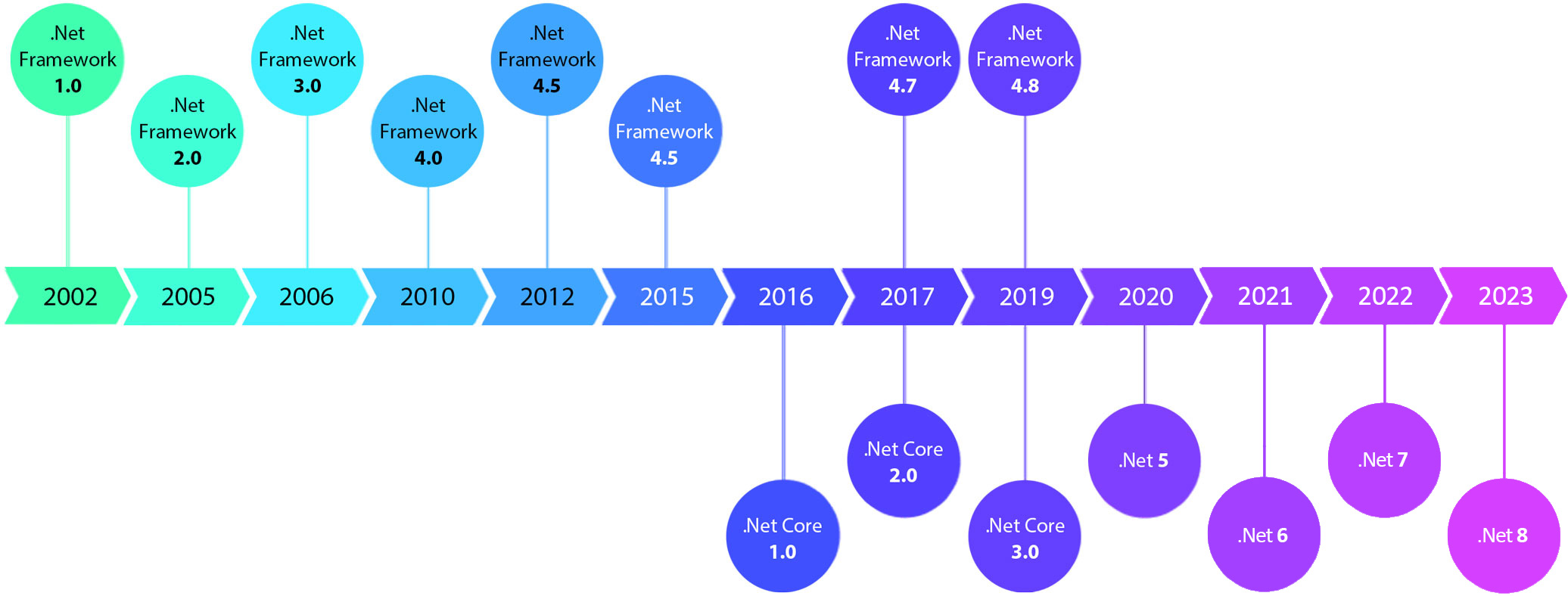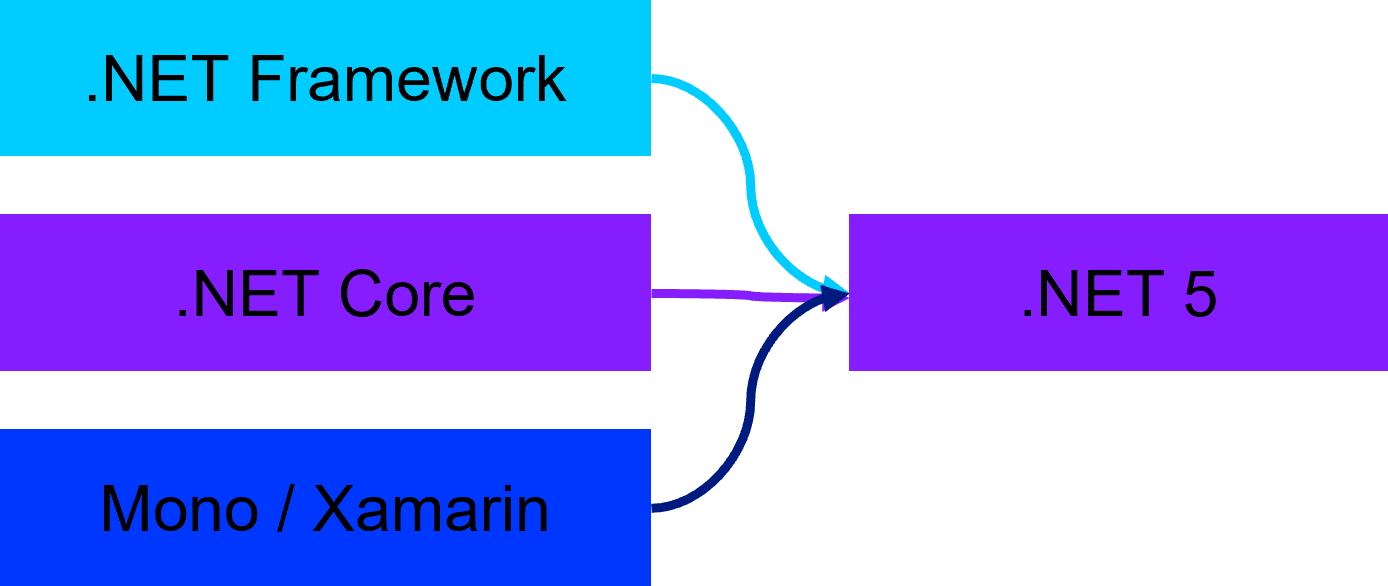November Happy Hour will be moved to Thursday December 5th.

.NET is a free, open-source development platform for building many kinds of apps, such as: Web apps, web APIs, microservices, cloud native apps, mobile apps, desktop apps, and Internet of Things (IoT). .NET apps are also supported cross platform, meaning it is compatible with many operating systems, including: Windows, macOS, Linux, Android, iOS, tvOS, and watchOS.
With .NET, your code and project files look and feel the same no matter which type of app you're building. You have access to the same runtime, API, and language capabilities with each app.1
.NET 5.0 is the first major release of .NET Core following 3.1. Here are some highlights about the history of .NET, what's the release lifecycle, what's the supporting policy, and more.2
History
The development of the .NET Framework was started by Microsoft back in the late 1990s under the name of Next Generation Windows Services (NGWS) which was later changed. By late 2001, the first beta versions of it was released, and on February 13 2002, the first public version of the .NET Framework as released.2
New versions of .NET Framework continued to be released: 1.0, 2.0, 3.0, 4.0, 4.5, 4.6, 4.7, and the final version of 4.8 on April 18 2019. The last release of 4.8 was Build 4115 on May 1 2021.2
The decision to stop working on .NET Framework was announced on November 12, 2014, when Microsoft decided to put all the efforts into providing cross-platform support for .NET with a new version called .NET Core.3
.NET Core released its first version on June 27 2016 and continued to make releases of the following versions: 1.1, 2.0, 2.1, 2.2, 3.0, and 3.1.3 Following 3.1, the next release changed its name from .NET Core to .NET, and the number went from 3.1 to 5.0. There were two reasons behind the name change:4
- Skipping version numbers 4.x to avoid confusion with .NET Framework 4.x.4
- Dropping "Core" from the name to emphasize that this is the main implementation of .NET going forward.4
First version of ASP.NET Core (.NET 5) was released on November 10 2020 and .NET 6 released on November 9 2021 at the .NET Conf 2021.

Releases
Releases are usually categorized into either Long Term Support (LTS) or Current. LTS releases get free support and patches for 3 years, whereas Current releases are for 18 months. New major releases are scheduled for every year in November. Even numbered releases are LTS while odd numbered releases are Current.5
For the latest released versions, .NET 6 is on a Long Term support level and the end of support is scheduled for November 12 2024. Whereas .NET 5 is on a Current support level and the end of support was scheduled for May 10 2022.5

Support
End of support refers to the date when Microsoft no longer provides fixes, updates, or online technical assistance. End of support may also be referred to as 'end of life' or abbreviated 'EOL'. This is the time to make sure you have the latest available update installed.5
Updates are cumulative, with each update built upon all of the updates that preceded it. A device needs to install the latest update to remain supported. Updates may include new features, fixes (security and/or non-security), or a combination of both. Not all features in an update will work on all devices. Update availability may vary, for example by country, region, network connectivity, or hardware capabilities (including, for example, free disk space).5
Future of .NET
Microsoft's vision is to have an unified platform. With just one .NET, you will be able to use it to target Windows, Linux, macOS, iOS, Android, tvOS, watchOS and WebAssembly and more.6 And with just one .NET, you will have a single set of APIs, languages, and tools to target a broad set of application types, including mobile, cloud, desktop, and IoT.7

.NET 5 is the next step forward with ASP.NET Core, with the aim to improve .NET in a few key areas:6
- To produce a single .NET runtime and framework that can be used everywhere that has uniform runtime behaviours and developer experiences.
- To expand the capabilities of .NET by taking the best of .NET Core, .NET Framework, Xamarin and Mono.
- To build a product out of a single code-base that developers (Microsoft and the community) can work on and expand together and that improves all scenarios.

What's new since .NET 5
Here are some highlights of what's new since .NET 5.4
Improvements and Features
Here are some of the improvements and new features available for .NET 5.0 compared to .NET Core 3.1:
- C# updates - records, relational pattern matching, top-level statements, and more
- F# updates - interpolated strings, and more
- Visual Basic updates - support extension
- System.TextJson new features - preserve references and handle circular references, HttpClient and HttpContent extension methods, allow or write numbers in quotes, and more
- Single file apps
- App trimming
- Windows ARM64 and ARM64 intrinsics
- Tooling support for dump debugging
- The runtime libraries are 80% annotated for nullable reference types
- Performance improvements
.NET vs .NET Framework
.NET 5.0 is the main implementation of .NET going forward and .NET Framework 4.x is still supported.
Some of the technologies on the .NET Framework are not going to be migrated over to .NET 5, here are some alternatives for them:
- Web Forms: ASP.NET Core Blazor or Razor Pages
- Windows Workflow (WF): Open-source CoreWF or Elsa-Workflows
.NET vs .NET Standard
Sharing code between .NET 5 workloads is simplified by allowing application development to specific the Target Framework Moniker (TFM) to net5.0.
Although net5.0 combines and replaces the netcoreapp and netstandard for .NET 5.0 apps and libraries, netstandard2.0 is still required when planning to share code between .NET Framework, .NET Core, and .NET 5 workloads.
Windows Communication Foundation
Windows Communication Foundation (WCF) was originally implemented to only be supported on Windows. However, there is a client port available from the .NET foundation, which is entirely open source and cross platform.
Next Steps
References
- "Introduction to .NET". Retrieved 27 October 2021.
- ".NET Framework version history". 8 October 2021. Retrieved 27 October 2021.
- ".NET". 20 October 2021. Retrieved 27 October 2021.
- "What's new in .NET 5". 15 September 2021. Retrieved 27 October 2021.
- ".NET and .NET Core Support Policy". Retrieved 27 October 2021.
- "Introducing .NET 5". 6 May 2019. Retrieved 28 October 2021.
- "Announcing .NET 5.0". 10 November 2020. Retrieved 28 October 2021.
Last updated: Sep 22, 2022


